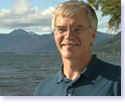| INTERVIEW
TRANSCRIPT - William Bergmann
For salmon, in-season management means going out and looking on a daily basis and seeing how many fish are coming in. If there aren’t any fish coming in, we close the fishery down. If there are, we open more area up.
We used to do things based on pre-season forecasts, and relied on those heavily. But it hasn’t worked. The fisheries don’t survive. We just can’t tell how strong the runs are going to be or how weak they are going to be. So we have to go out in season and check them all the time.
The only way that works is if what you think is going to happen before the season starts is actually what happens. And we all know Mother Nature is very, very fickle. Sometimes she returns a lot of fish, and sometimes very few. We have to respond to that, otherwise we are going to overfish the resource. And we don’t want to do that. We are here to preserve it for the future, not just for today.
We fly around in a little plane, The Supercub, the pilot and I. And we count fish and we compare it to what we think should be in there this time of year. And if it looks better than that, then we open the areas that are adjacent. And if it doesn’t, we end up closing them, or not opening them.
We count the fish. When I am flying along I am looking down at the salmon stream and you can see the different species of fish. They usually come in at different times. You can see the different concentrations of them. When they just start to come in, you can see them -- just a few fish. And you count ‘em by the hundreds, maybe. When there’s more, you count ‘em by the thousands and when you’re by Ann Ann you’re counting them by the ten thousands. That’s how many fish are there. And then I just relate that to what I’ve seen in the past.
Having the fishery run by the people that know the most about the salmon run in season is the only way that the runs survived. And if it was politically motivated, and there was some reason we had to fish, eventually we’d over-harvest the salmon. But that isn’t how we do it. I cover an area of about fifty miles on either side of this community and look at the salmon in each different area every three days and based upon that I’ll have either an opening for fishing or won’t have an opening for fishing.
At times, fishermen get extremely aggravated about the things I do but they realize, in the long run, that if we want fish several years from now, we have to conserve them. And, it’s not a pleasant thing. You know, people have their livelihoods, their incomes, boat payments. You’ve got to put food on the table for the winter. But they realize you can’t overfish the resource this year and expect it to come back strong in years to come. It just doesn’t work.
Well, since 1960 in statehood, the fish were at a pretty low level. And we have had the benefit of Mother Nature. The runs have rebuilt themselves, with our help. And it’s been very positive watching this happen. And this doesn’t mean the runs won’t go down. Last year we had the biggest run ever recorded in mankind. This year, we’re probably going to have a run that is probably the worst in the last ten years. But we have responded by not opening a lot of the areas so we can get the escapement for the future.
Well, I have been doing this for twenty-eight years. And although there are a lot of negative things about it, the plusses far outweigh the negatives. Being able to do this, being able to watch the resource, how it has responded. It’s been just fantastic.
We were given a lot of latitude with statehood. Conservation is a key part of Alaska. And if you don’t have conservation, you’re not going to be able to have fish for the future, whether it’s in-season management or it’s some other type of thing. You’ve gotta be able to shut down the fisheries when things aren’t right. That way, when things are right, you have exceptional fisheries.
If you don’t have some idea of how much you’re catching, you don’t know what you are taking out of the resource. So, you might think that everything is well and good, but if you are catching a lot more and you can’t immediately respond to it, you are going to over-harvest things. So you have to have the cooperation of the fishermen and the harvesters. They cooperate, but it’s a legal responsibility. You have to have that catch reporting; otherwise you are going to over-harvest the resource. That’s just a given fact. You can’t be out there taking all you want without knowing how much you’re taking and still think that you’re going to get enough for future. There are a number of other users of this resource besides just man. As you saw up there, the bears eat a lot, the seals, sea lions. Everyone gets their share of the salmon. And we don’t manage for that specifically, but we allow enough upstream so that there is going to be plenty for everybody.
|
 William
Bergmann is an area management biologist with the Alaska Department
of Fish and Game in Petersburg, Alaska.
William
Bergmann is an area management biologist with the Alaska Department
of Fish and Game in Petersburg, Alaska.